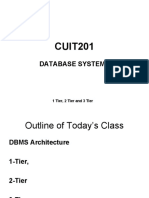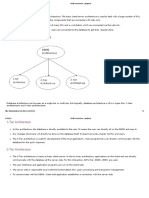0% found this document useful (0 votes)
7 views3 pagesArchitecture DBMS
DBMS architecture outlines user interaction with databases for data management. It includes 1-Tier, 2-Tier, and 3-Tier architectures, each varying in how clients communicate with databases. The 1-Tier architecture allows direct interaction, the 2-Tier uses a client-server model, and the 3-Tier introduces an application server for larger web applications.
Uploaded by
prathameshmartawarCopyright
© © All Rights Reserved
We take content rights seriously. If you suspect this is your content, claim it here.
Available Formats
Download as PDF, TXT or read online on Scribd
0% found this document useful (0 votes)
7 views3 pagesArchitecture DBMS
DBMS architecture outlines user interaction with databases for data management. It includes 1-Tier, 2-Tier, and 3-Tier architectures, each varying in how clients communicate with databases. The 1-Tier architecture allows direct interaction, the 2-Tier uses a client-server model, and the 3-Tier introduces an application server for larger web applications.
Uploaded by
prathameshmartawarCopyright
© © All Rights Reserved
We take content rights seriously. If you suspect this is your content, claim it here.
Available Formats
Download as PDF, TXT or read online on Scribd
/ 3


























































